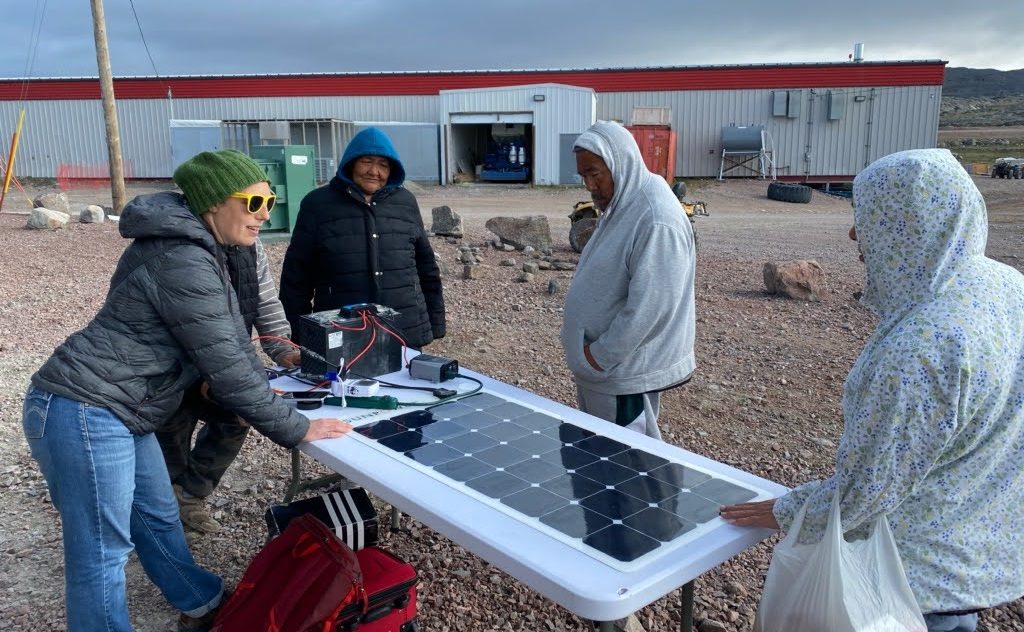Nunavut residents need support for renewables
While travelling from our Arctic office in Iqaluit to the western Nunavut hamlet of Kugaaruk this summer, I stopped in Cambridge Bay to check out the Canadian High Arctic Research Station (CHARS) and, in particular, the solar panels on the side. It’s a good-looking building, and a good-looking solar array, but the 10-kilowatt (kW) installation wasn’t currently producing any renewable energy for the community.
While this was disappointing, it wasn’t completely surprising.
In Kugaaruk, I saw the same problem with the 12-kW solar array installed on its arena to help power the community freezer back in 2016. Community freezers are an important piece of infrastructure as they allow harvesters to store their country food whole — and solar power is a good fit because community freezers are needed most in summer when there’s plenty of sun to help power the system.

The issue is that the territory’s electrical utility, Qulliq Energy Corporation (QEC), hasn’t yet released its Independent Power Producer program, which would allow people to generate solar energy for use elsewhere in the community (like in the summer, for example, when they don’t need as much of it). Until then, renewable energy installations greater than 10 kW can’t be connected to the grid and therefore can’t reduce customer cost and carbon emissions.
I’ve been working with Kugaaruk’s hamlet leaders, QEC, two solar installation companies and electrical inspectors to come up with a solution for getting the arena’s solar energy system connected to the grid. The community wound up having to pay a southern-based solar installer in August to retrofit the array to 10 kW in size.
Communities are ready for renewable energy — they want to use less diesel, save money on electricity and protect the environment. But one of the biggest stumbling blocks right now is a lack of policy that supports renewable energy.
Despite QEC’s slow pace, they are heading in the right direction. To help, the Government of Nunavut could play a leading role by setting territory-wide green energy targets and emission-reduction targets.
Kugaaruk Community Energy Champion
I was also in Kugaaruk to work with Alex Ittimangnaq, Kugaaruk’s Community Energy Champion. Alex had invited me as his mentor to help kick-start the community engagement aspect of NRCan’s Indigenous Off-Diesel Initiative (IODI). This three-part program includes green energy project management training for Alex, Community Energy Planning for the Hamlet, and the implementation of a community-scale green energy project.
Covid-19 had delayed plans for a few months, but when travel within Nunavut became possible, I went to Kugaaruk with my solar demonstration kit to help people understand what sort of renewable energy options are out there, get feedback on the types of projects they’d like to see, and answer questions.
Alex’s job will be to help bring people together for discussion, collect data on energy use in Kugaaruk and the ideas that appeal to the community, and gather information from all the stakeholders to eventually feed into a green energy action plan for the community.
Solar Education Event in Kugaaruk
Many people came by our public demonstration to learn about solar energy. Cabin owners were interested in setting up an off-grid solar panel system for their cabins so they wouldn’t need to take so much diesel out on the land. In the winter, solar could potentially be supplemented with wind energy systems.
Although they’re small, these kinds of projects help people understand the potential and limitations of renewable energy and help them imagine how it can fill a larger role in the community’s energy supply.

Why the Community Cares
In 2018, a cruise ship grounded near Kugaaruk, releasing diesel into the environment. While the spill was limited, it awoke the community to the serious environmental dangers of relying on diesel shipped into the community by boat.
The community in Kugaaruk is also growing rapidly. The coop grocery store is being expanded, there are plans for a Northern store, and new housing is in the process of being built.
In early October, Kugaruuk’s solar panels were finally connected to the grid, and will be able to power the community freezer in the summer. Cambridge Bay, however, is still waiting.
With a young, growing population and much new infrastructure being planned in the community, it’s important to ensure that new energy needs are met with the cleanest, greenest energy systems possible to safeguard the local environmental resources for the future generations.

